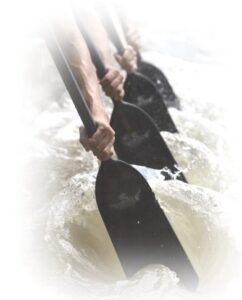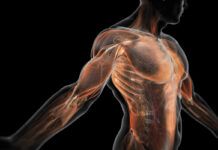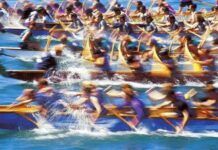Does the following story sound familiar to you?
You turn up at your first dragon boating session. Someone looks you up and down and says “You look like a 48”.
You are handed a 48 inch club paddle which looks how you would expect it to look, and weighs what you expect it to weigh. That is until you are handed someone’s personal paddle that seems like it’s made from AIR – but I digress.
You are instructed on the rudiments of “this club’s stroke” – catch, drive, exit, recover. And you are put in the boat.

Very soon you are wondering why the experienced person in front of you has smooth, powerful, noiseless stroke. Yet you are creating enough turbulence to make your washing machine proud and throwing more water than was delivered to Noah!
Why? What is happening in the water? Or more importantly, what SHOULD be happening in the water? You don’t know. YOU JUST DON”T KNOW!
Well, take a seat. Pour yourself a stiff … iced tea. And let me throw some science at you.
The most important piece of equipment for a dragon boat paddler is the paddle.
And perfect timing and power is of no use if you use your otherwise efficient paddle in an inefficient manner.
The paddler uses the paddle is to push against the water so that the boat goes forward.
Simple! Right?
Well, it is not as simple as it seems because the water doesn’t like to be pushed against. Instead it will try to move out of the way of the force.
We want to move the boat forward. Not move the water backwards.
The effort of moving the paddle through a stroke converts your body’s energy into motion. Ideally you would want 100% of the energy you put into the paddle to be converted into energy of motion for your boat. But we have already mentioned that a paddle stroke will move the boat forward but also move some water backwards.
So we have wasted some energy already.
So, to maximise the energy used to push the boat forward you have to minimise the energy you waste moving water. Simply, you should minimise the velocity you impart to the water as you paddle.
As a general principle it is more efficient to generate a propulsive force by pushing a large mass slowly than it is to push a small mass quickly.

So to have an efficient stroke you need to ensure the paddle blade is completely in the water. Putting more blade area in the water will automatically increase the mass of water you have to push against with an immediate increase in efficiency. You will immediately feel the paddle gain a better grip on the water. Even though it may feel harder to paddle, you will be using less energy to gain the same result so it is worth it.
A common mistake is to apply the power before the paddle is completely buried.
This can cause two problems:
1. Splashing. Your energy is converted to moving air and water instead of forward motion in the boat.
2. Ventilation. The paddle sucks air down the back of the blade when you insert it in the water or if you apply power too early.
No good!!
You are moving air instead of water. Air weighs a lot less than water and if there is air behind your paddle instead of water the mass of water you are moving is decreased. So to create the same momentum requires you to expend more energy.
There are three elements critical to paddle blade efficiency:
1. the volume of water the blade presses against,
2. the distance the blade moves the water, and
3. how quickly the blade begins to move the water.
So the take away from this post is that according to laws of motion and fluid dynamics, maximum efficiency in water is achieved by:
1. Pressing against the largest amount of water possible
2. Moving water for the shortest distance possible
3. While accelerating the force on the paddle – but not the water.
To understand this, imagine a paddler doing the complete opposite.
The paddler:
1. Places only half the blade in the water (i.e. press against a small volume), and
2. Pulls with so much force that the water starts to move
This stroke causes movement of the water resulting in less force going into moving the boat — an inefficient stroke.
Thus, an efficient paddler:
1. Inserts the entire blade,
2. Exerts power gradually, accelerating the blade and
3. Ends the stroke as soon as the water under paddle blade pressure begins to move.
This is your most efficient stroke.
Attribution:
Text and graphics: http://www.guillemot-kayaks.com/guillemot/information/kayak_design/how_a_paddle_works















A good post on the science of getting the most out of your paddle.
Great article
The point on pulling slowly through water is a little counter intuitive. My coaches always say to accelerate the blade through the water to exit and recover quickly.
Hi Huron,
There is a difference between accelerating the paddle and accelerating the water with the paddle. Your coach is correct – you should accelerate the blade through the water. But we don’t want to accelerate the water that is captured by the blade – we want the water to remain as still as possible. Notice the first few strokes when a dragon boat first starts off – the blades are accelerating fast through the water but the boat is not moving as fast. Instead the water on the blade is moving. Not ideal. When the boat is moving at full speed – the acceleration of the paddle through the water is (almost) matched by the acceleration of the boat – that is what we want. So accelerate the blade – Good. Accelerate the water – Not good. I have edited the post to try and reflect this difference a bit better. Thanks for your comments.
[…] Original Article […]
Amazing article! Thank you very much
Thanks Aldo. If we can understand how the paddle works, we can begin to work on our blade work to maximise our efficiency.
Thanks for sharing your experience.
A point I always miss in articles is the position of the paddle and blade in relation to boat and water.
Most of us hold the paddle in an angle of 5-10° to the water line, especially if we get tiered and the top hand drops.
The result is a distance between blade and boat of approximately 10 cm.
Personally I try to hold the paddle straight and as close to the boat as possible.
It feels for me more stable.
My theory is that the water can create only at one side turbulences and because it’s basically captured in a corner it can’t move that much at all.
Would be interested to know your opinion.
Hi Andreas.
You make a great point and I agree with you. Like you pointed out, keeping the paddle close to the side of the boat prevents the water on the face of the blade closest to the hull from sliding off so easily.
This will result in a higher load on the part of the blade closest to the hull than on the part of the blade away from the hull. This will impart a twisting force on the paddle. Therefore the paddler will need a strong top wrist to prevent the paddle from twisting.
If you draw the effect on paper you will notice that keeping the blade close to the hull effectively makes the blade wider!! Hard to explain in words, easy in a drawing. (Maybe a future post)
There is also another reason why keeping your paddle close to the side of the boat is good which I will cover in a another future post.
Hi Mark, just s question; do you have a science degree?
Hi Jeremy, I have an engineering degree and an obsession with dragon boating.
Question
If our team all have different paddle weights and makes will our time be slower than if we all had same brand of paddle?
Hi Gloria
I do not believe that paddle weights or paddle brands have a material effect on your boat speed.
That said, there is a conversation to be had around wooden vs carbon fibre paddles (i.e. flexible vs rigid).
And depending on your club’s technique and stroke rates, the length of paddles may be a consideration.
You are giving me some good ideas for future posts.
Hi Mark,
At what depth is paddling inefficient? We have a coach that encourages us to bury the blades so deep that half of our forearms are buried also. This doesn’t feel particularly powerful and I have been watching other teams this season and don’t see this same technique happening – so I’m wondering if it’s not effective, what is the most efficient blade depth and why?
Hi Rachel
That is a very good question. One that deserves a more detailed answer to this one. In short, a dragon boat blade slips through the water to varying degrees depending on angle of the blade, power on the blade, density and other features of the water, speed of the boat and … yes… depth of the paddle. A blade that is 1 cm deep into the water slips through easily and provides little propulsion. (Try it) A half-buried blade slips a little less and provides a little more propulsion. A fully buried blade slips even less and provides more propulsion. Therefore, it seems that the deeper the blade, the less the slip (good) and the more propulsion (good). However, a slipping blade is actually protecting us as a paddler from the harsh reality that no slip (i.e. 100% grip) is a truth we cannot handle.
Imagine how hard a stroke would be if the blade was so deep that it gripped onto the bottom of the river and your body had to provide enough forces to move the boat. It would be extremely difficult, and the stroke rate would be very low. Going deep is good but not too deep. What is the best depth for a blade? That is a question for your coach but the “proof is in the pudding”. If your crew goes faster with paddles buried halfway up the forearm, then the strategy obviously works. That said, I would assume that the boat speed would need to be very high for mere mortals to be able to handle such a load on the blade.
Thanks for the insightful question. I may address this topic in a future post.
Mark